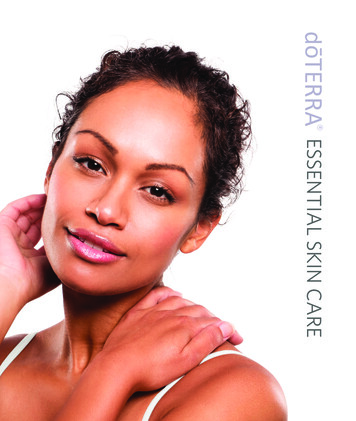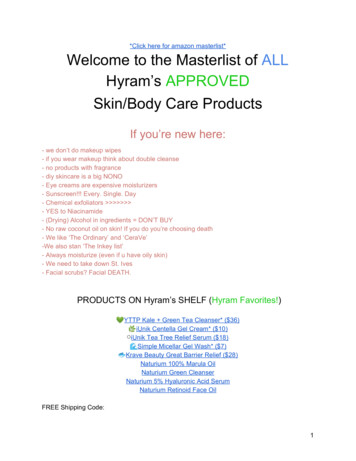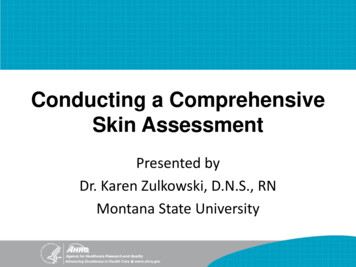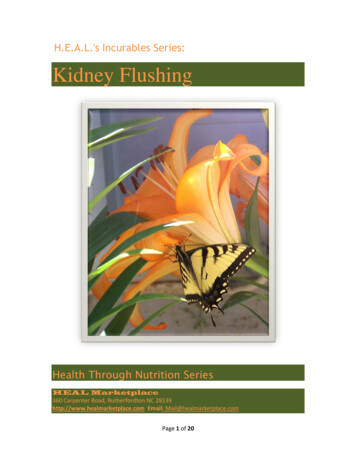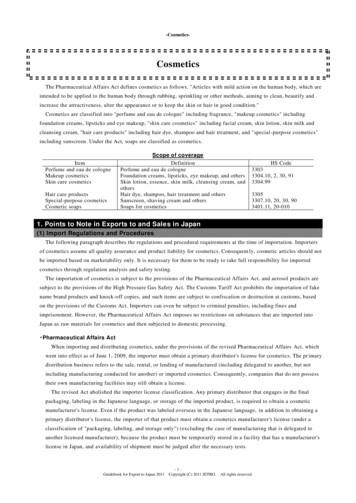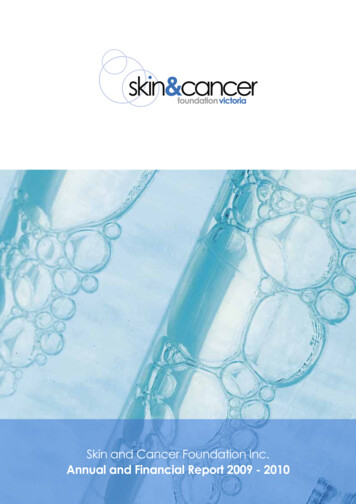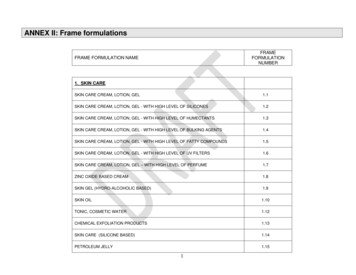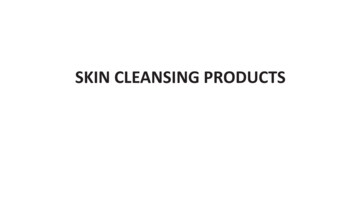
Transcription
SKIN CLEANSING PRODUCTS
SKIN CLEANSING PRODUCTS Human skin is in continuous contact with the environment,which can modify its normal flora, pH, and barrier properties,leading to unwanted conditions. Skin cleansing serves as a foundation for healthy skin with anintact barrier function, and it also contributes to the skin’saesthetic appearance. It includes the removal of dirt, oil, cosmetics, and dead skincells. In addition, skin cleansing is the initial step in overallskin care and prepares the skin for the application ofmoisturizing, protective, and nourishing products.
How Skin Cleansing Products May Affect the Skin? Dirt found on our skin consists of sweat, sebum and its breakdownproducts, dead skin cells, residues of cosmetics and personal careproducts applied to the skin, dust, and other environmentalimpurities carried in the air. Most of these compounds are not soluble in water, so washing theskin with simple water would not be sufficient to remove dirt.2 Skin cleansing products contain surfactants that are capable ofemulsifying water-insoluble ingredients into micelles, which canbe easily washed away from the skin.
Unfortunately, many skin cleansers do cause changes in theskin’s structure and barrier function, leading to irritation,dryness, redness, and itching. The major negative effects of skin cleansers and additionalconcerns are summarized as follows:
Dehydration of the skin and weakening skin barrier: Many skin cleansers solubilize lipids that are found on the skinsurface to provide protection and may even extract skincomponents, such as the NMF (natural moisturizing factor)during cleansing. Surfactants may also remain in the SC after even rinsing theproduct with water. Surfactants can disrupt the SC’s structure,and weaken its barrier function leading to dehydration of theskin. Surfactant penetration can cause irritation and inflammationand alter barrier renewing processes by affecting desquamation.
Damage of skin proteins It has been shown that the tendency of surfactants todamage skin proteins is related to the charge density of thesurfactant aggregates. This explains the following well-known order for the irritationpotential of surfactants, namely,anionic surfactants amphoteric surfactants nonionicsurfactants.
Damage of skin proteins As cleansing products are primarily based on anionicsurfactants, approaches have been developed to decreasethe tendency of these surfactants to damage skin proteins. Common approaches include increasing the size of thehead/polar group of the surfactant and using a combinationof anionic surfactants with amphoteric or nonionicsurfactants.
SC damage Another factor that may contribute to SC damage is thecleanser’s pH. Soap-based cleansers are alkaline in nature, while the pH ofmost syndets (synthetic surfactant-based cleansers) is closeto neutral or slightly acidic. Soap-based cleansers have a higher potential to irritate skinthan cleansers with synthetic surfactants (syndets).
Irritation, itching, inflammatory responses, and allergies Surfactant or other ingredients penetrate into dermal layersto trigger such conditions. An increase in the production of cytokines can also elicit aresponse from the dermis. If soaps damage the skin barrier, they can easily get into thedeeper layers of the SC, leading to irritation, reddening, anditching.
Resistance of microorganisms A number of hygiene products, including many with antimicrobialactivity, have become available. It has been demonstrated in clinicalstudies that antibacterial agents, such as ethanol, isopropanol,chlorhexidine, are effective in preventing diseases. However, concerns have arisen with regard to the long-term safety ofsome ingredients. It is questionable whether some ingredients mayincrease the resistance of microorganisms to antimicrobials. If these agents increased the resistance of antibiotic resistance, it maylead to an increase in the number of multiresistant microorganisms,increasing costs for patients and their families, and even the numberof deaths in healthcare settings.
Long-term changes in the skin There are some occupations where frequent handwashing is a must; examples include healthcare settings,such as pharmacies and hospitals; pharmaceuticalmanufacturing companies; as well as the food industry. In such cases, frequent handwashing may lead to longterm changes in the skin, such as chronic damage, irritantcontact dermatitis and eczema, and concomitant changesin skin flora.
ChemicalNature andMildnessSoapsSyntheticSurfactantsClassification of cleansers based on:CleaningFoamability Product Type solvingSolventFoamingFacialSolidLow foamingBath andshowerLiquidNon foamingSemisolidHandPhysicalSanitizers
Classification Based on Chemical Nature and Mildness Soaps Soaps are salts of fatty acids. If the alkali used containssodium, potassium, or ammonium ions, water-solublesoaps are formed, whereas zinc and magnesium makeinsoluble so-called metallic soaps. Skin cleansing products contain water-soluble soaps. ThepH of soaps is alkaline and is usually in the range of 9.5–10.This is one of the main reasons why soap-based cleanserscan irritate the skin.
Soaps Soaps are amphiphilic molecules having bothhydrophilic and hydrophobic groups, i.e., they aresoluble in both oil and water. They are anionic surfactants. Soaps are often referred to as natural surfactants sincemost oils and fats used for their production can befound in nature.
Synthetic surfactants Often referred to as “soapless” soaps or syndets, They are also amphiphilic compounds. The most frequently used surfactants are anionic innature, similar to soaps; however, they are muchmilder to the skin and are, therefore, more popular. The difference in the chemical structure of themolecule and the pH of the final product (usuallyaround pH 7) makes them much milder.
Syndet bars are made using blends of syntheticsurfactants, they are a different product,formulation and chemistry to that of traditionalvegetable soap bases. Syndet soap surfactants are derived from oils,fats, or petroleum products that are processed ina wide range of chemical processes other thantraditional saponification
Solvents Nonpolar solvent-based products, such as thosecontaining mineral oil, may be potentiallyadvantageous for dry skin consumers; however, theymay be disadvantageous for users with oily skin. Skin cleansing products containing alcohol can dry theskin, which may be beneficial for oily skin but not fordry skin. It is very important, therefore, to select skin cleansingproducts in accordance with the skin type.
Classification Based on Cleaning Principle Two basic mechanisms can be attributed to thecleaning effect, namely, chemical cleaning and physicalcleaning. Chemical cleaning can be achieved throughemulsifying and dissolving the dirt on the face(solvent-based systems).
Emulsifying Surfactants work by reducing the interfacial tension between oiland water, i.e., emulsifying oily components on the surface ofthe skin with water. The stronger the surfactant, the more hydrophobic materialremoved, the greater the potential skin damage from excessiveremoval of naturally occurring skin lipids and the greater thecompromise of the skin barrier function. Correct and careful selection of surfactants is required to ensureproper mildness. Soap- and surfactant-based cleansers usuallyrequire water and generally include a rinsing step.
Dissolving “Solvent-based systems” Solvent-based systems clean the skin bydissolving sebum and external oils present onthe skin as residues of cosmetics and similarmaterials. Solvent-based cleansers are usually not used inconjunction with water; rather, they are appliedand then wiped off with a tissue or cotton ball.
Physical cleaning is an alternative to chemicalcleaning; the working principle is abrasion (friction),which is generated primarily by the direct interactionof a washcloth, tissue, cotton ball, cleansing cloth, orabrasive particles and the surface of the skin. Friction works to help remove dirt and increase theinteraction of chemical cleaning agents with oils.
Classification Based on Foamability Foaming cleansers: Contain a significant amount of well-foaming surfactants. These products are the most popular today and often providethe most refreshing sensation afterward. Most body washes,hand soaps, and facial cleansing products belong to thiscategory.
Foaming cleansers: These products are typically surfactant solutions, gels, scrubs,and O/W emulsions with a high cleaning power. Foaming products can contain the same basic ingredients forthe body and the face. However, for the face, a differentsensation and greater mildness are required. Therefore,generally, combinations of milder surfactants are used. Although these products contain mild surfactants, they can stillsignificantly damage the skin barrier if left on the skin for alonger period of time.
Low-foaming products contain a lower level of well-foaming surfactants compared tofoaming products and are milder to the skin. Product forms available as low-foaming products includelotions, gels, scrubs, and creams. They still foam when mixed with water; however, mildness isoften obtained at the expense of effective cleansing andlathering.
Low-foaming products These products primarily contain nonionic surfactants,often combined with amphoteric and polymeric types. Foam-booster secondary surfactants may also beadded to increase the user experience. Low-foaming products are typically marketed for theface, but in some cases, for the body as well.
Non-foaming include surfactant solutions, creams, lotions, bath oils,bath salts, and toners. Cleansers in this category tend to be the mildest due totheir low well-foaming surfactant or soap content. Non-foaming cleansers can be solvent-based, such as facialtoners and hand sanitizers, and emulsion-based, such asmost facial cleansers, body washes, and hand soaps (whichsolubilize dirt).
Non-foaming Emulsion-based non-foaming products contain the highest levelof oils compared to the other two groups; therefore, they areideal for depositing a thin layer of oil onto the skin, whichremains on the skin even after rinsing. For this reason, thesepreparations are generally more effective for dry skin users andnot recommended for oily and acne-prone skin. They are primarily formulated for the face and, in some cases,for the body. Emulsion-based products are often referred to as moisturizers oremollient body washes.
Classification Based on Product Types Solid cleansing aids, such as soap bars, bath salts, bath beads,and cleansing wipes Liquid products, such as surfactant solutions, low-viscosityemulsions, toners Semisolid products, such as creams, pastes as facial masks,scrubs, and gels. It is important to understand that a creammay be foaming, low-foaming, or non-foaming, depending onthe ingredients it is made of.
Classification Based on Application Surface Facial cleansers include lathering and foamless emulsions, gels,scrubs, toners, masks, and cleansing wipes. Bath and shower products such as bar soaps, bath salts, bathbombs, bath oils, bubble bath products and shower gels. Hand cleansing products include bar soaps and syndet bars as wellas liquid soaps. They are often enhanced with additionalmoisturizing ingredients. Hand sanitizers are used specifically to remove microorganismsfrom the hands with the intent of preventing infections andreducing the spread of infectious diseases. They include bar soaps,gels, lotions, creams, and cleaning wipes.
Typical Ingredients in Skin Cleansing ThickenersAntibacterial agentsSkin conditioningAbsorbentsagentspH buffersAstringentsAbrasivesVitamins and exoticnatural ingredientsColorants
Surfactants act as cleansing agents and emulsifiers. Anionic surfactants have good lathering and detergentproperties, which are necessary to remove dirt. As mentioned earlier, natural soaps are anionic molecules as well. Cationic surfactants have a positive charge which makes themattracted to the skin. Therefore, they can be employed asconditioning agents. Amphoteric surfactants are well tolerated and lather well and,therefore, are also often used in facial cleansers as secondarysurfactants to help boost foam, improve conditioning, and reduceirritation.
Nonionic surfactants, are very mild; thus, they arecommonly used as emulsifiers, conditioning agents, andsolubilizers. Their main drawback is that they do not lather particularlywell. However, they form a perfect combination withanionics. Usually, different types of surfactants are used incombination with each other to build appropriateproperties into the formulations.
Anionic surfactants have excellent foaming andcleansing power; however, they are generallyirritating. Therefore, they are often combinedwith nonionic and amphoteric surfactants, whichact as secondary surfactants and decrease theirritating potential of anionic surfactants and leavethe skin with a pleasant feel as well as contributeto foam stability.
Thickeners Surfactant-based products can be thickened byincreasing the surfactant concentration; using various hydrophilicthickening agents, such as cellulose derivatives, gums, and acrylicacid derivatives; and, in certain cases, adding sodium chloride. Skin conditioning agents (otherwise known as moisturizers)counteract the SC-disruptive properties of soaps and surfactants. Cleansing agents may contain various types of moisturizers,although part of them is removed from the skin when rinsingwith water. Therefore, significant amounts of moisturizers willnot be left on the skin surface after cleansing. This is why propermoisturization is important after cleansing the skin for all skintypes.
Foam stabilizers are generally surfactants, which do nothave a good foaming property by themselves; however,they can improve the stability of foam generated byanionic surfactants. The most frequently used ingredients include nonionicsurfactants, such as cocamide DEA. Abrasives Facial scrubs contain specific exfoliatingcomponents that are responsible for physical cleaning.
Antibacterial agents are widely used in today’s formulations. Theymay be beneficial for controlling certain skin conditions, such asacne; superficial skin infections, such as folliculitis; and controlinfections after exposure to dirt or other potential sources ofcontamination. These are generally considered active ingredients in products. The most commonly used compound is triclosan; however, itssafety and efficacy are currently being investigated in cleansingproducts by the FDA. Additional examples include benzoyl peroxide and lactic acid(soaps containing a higher amount of lactic acid have an acidic pH,which is thought to be antibacterial).
Absorbents are mainly used in facial masks to absorbsebum from the skin. These are water insoluble, mainly inorganic compounds. Examples include zinc oxide, titanium dioxide, kaolin,calamine, clay, and natural mud. Astringents are the major ingredients in facial toners.They tighten pores and refresh the skin. Most of themare generally considered active ingredients. Examples include alcohol and witch hazel.
Many consumers focus on whether they have acne-proneor sensitive facial skin, but do not take into account theirbody skin type. The type of the skin changes over time and may vary evenamong different body parts in individuals. One may have combination facial skin, normal body skin,and extremely dry hand skin. Therefore, the type of product used should be carefullyselected according to the skin’s needs.
Products types of cleansersBar soapsSyndet barsGelsScrubsCreams and lotionsTonersMasksCleansing WipesBath saltsBath bombsBath beads (i.e., capsules)Bubble bathBath oils
Traditionally, bar soap made with natural surfactants was usedas a skin cleanser. It is effective in removing grime and is relatively inexpensive however, the washing solution formed by soap is extremelyalkaline (pH 9.5–11.0) and can cause irritation, dryness, andscaling. Superfatted soaps contain more oil than required to astoichiometric reaction. The excess oil may serve as amoisturizer and an emollient and improves the mildness of theproduct
Transparent soaps have a higher concentration of glycerin,which is a skin moisturizer. Although they contain naturalsoaps and therefore their pH is alkaline, they are stillconsidered milder due to the presence of glycerin. An additional disadvantage of natural surfactants when usedin bathtubs is that they tend to form scum and rings on thewall of the tub in the presence of hard water. Soap rings donot rinse away easily. In addition, they tend to remainbehind and produce visible deposits on clothing and makefabrics feel stiff.
Syndet bars are similar to soap bars, although theycontain synthetic emulsifiers instead of natural soaps. Therefore, syndet bars have a better skin compatibilityprofile than traditional soaps. Their cleaning effect is very good, and the residue left onthe skin is minimal. Due to their more gentle nature, they are becomingmore important as skin cleansers. Nearly all common synthetic detergent bars are based onan anionic surfactant, acyl isethionate.
Many consumers relate the shape and name tothe harsh effect regular products would cause.Most consumers are not aware that a soap inthe form of a bar can be made of differenttypes of surfactants and is, therefore, notnecessarily harsh.
Cleansing gels are water-based systems, containingvarious types of thickening agents they typically have atransparent appearance. Gels are a popular cleansing form; they are used withwater since they are foaming formulations. Inert particles (i.e., beads) are often incorporated intogels, which may provide an additional exfoliating effect.
Scrubs are generally O/W emulsions or gels that containsmall particles of natural or synthetic origin. Scrubs are intended to provide a deep cleansing effect,including skin exfoliation from abrasion with the particles,and they also polish the skin. It is important to keep in mind that the skin regularly andcontinuously sheds; therefore, additional exfoliatorsshould not be used every day. They affect the skin barrierand can lead to damage if used too vigorously.
Massaging and rubbing these preparations onto theskin must be done with the utmost care andgentleness and in strict accordance with themanufacturer’s instructions. Exfoliating agents help physically remove dirt andcellular debris from the skin and provide a smoothskin surface. They are advantageous for aging skin, acne, andother skin conditions when high exfoliation isrequired.
Cleansing creams and lotions are typically O/W emulsions. Themain difference between a cream and lotion is their viscosity;lotions have lower viscosity. They are usually made of relatively delicate surfactants, and theirirritation potential is much lower than that of soaps. They can be lathering, low-foaming, or non-latheringformulations. Although cleansing creams and lotions may deposit moisturizeringredients on the skin, they should not be used as moisturizersand left on the skin. These products contain cleansing agents thatare mild; however, if left on, it may lead to irritation. For the samereason, it is preferable to wash them off the skin than just wipingthem off with a dry cloth.
Toners are clear solutions, generally based on varioustypes of solvents and a low amount of surfactants. Waterless cleansers for the face are often based onalcohols and glycols since sebum is soluble in thesesolvents. Toners are usually applied with cotton balls, tissues, orwashcloths and evaporate quickly after application. These products may be beneficial when there is noaccess to water and can be effective for very oily skin;however, long-term use may be harmful to the skinbarrier.
Toners are popular for younger users because of theperceived acne benefits and pore-tightening effect dueto the presence of astringents. Facial toners are mainly used after cleansing to removesoap, oil, and makeup residue from the skin. As they contain astringents, they can dry the skin andleave it with a tight feeling. They are a good option for oily skin users; however,they are not recommended for consumers with dryskin.
Facial masks are a unique product type for cleaning the face. Certain products are rinsed off with water, while others canbe peeled off as a film. Masks that rinse off are removed from the skin with warmwater 15–30 min after application. They usually contain insoluble, absorbent materials, such asclays, zinc oxide, kaolin, and others. These masks caneffectively absorb sebum on the skin and, therefore, areprimarily recommended for users with oily skin. Certain rinse-off masks are based on moisturizers and/orcleansing agents and do form an actual dried layer on theskin. They are more beneficial for users with dry skin.
Masks that peel off are made of rubbery substances,such as polyvinyl alcohol or rubber-based substances,such as latex. As these masks dry on the skin, theyharden and form a thin, flexible, and usually transparentfilm on the skin. This film can be easily peeled off the face. Their major benefit is that they increase the skin’s watercontent by inhibiting water evaporation. Therefore,these masks are recommended for persons with drierfacial skin.
Cleansing wipes, often referred to as cloths They are quite popular as they offer ease of use. Cleansingwipes are beneficial in cases when there is no access towater. They are usually designed to be used for one time only;therefore, they can be more hygienic than bar soaps. They consist of low levels of mild detergents with additionalconditioning ingredients that may be deposited on the skin. The wipes can be made of natural fibers, such as cotton,synthetic fibers, such as polypropylene, or a blend of these. Wipes clean the facial skin by a combination of physical andchemical cleaning, which may provide much cleaner skin.
Two popular product types are available today: dry wipes and wet wipes. Dry cleansing cloths consist of lathering surfactants that are depositedonto a disposable cloth. In addition, moisturizing ingredients such asglycerin can also be deposited onto the wipes. The cloth is to be wettedbefore use and rubbed to generate lather. Wet cleansing cloths are pre-wetted by the manufacturer and packagedand distributed in a ready-to-use form. Wet clothes are used without additional water; they are generally nonfoaming types. The major advantage of wet cloths is that small amounts of moisturizerscan be deposited on the skin. This property makes these products highlyfavorable for users with dry skin.
Bubble bath products, also known as foam bathproducts, are intended to fill the bath with a light,frothy lather. In general, shower gels and shower creams do notfoam as much as bubble bath products do, and theirviscosity is higher than that of bubble bath products.
Bath Oils These are oily products containing a high amount ofemollients, often combined with fragrances. They are intended to be used in the bathtub to moisturize theskin. Bath oils and essences are typically non-foamingformulations. The main ingredients of such formulations are the emollients. Mineral oil was incorporated as the main emollient since ithas excellent hydrating properties. It forms an occlusive layer on the skin and prevents water lossthrough the skin. Its major disadvantage is that it may feelheavy and greasy on the skin.
Bath Oils Newer emollients used in bath oils include isopropylesters; polypropylene glycol (PPG) ethers; natural oils,such as olive oil. Surfactants act as solubilizers. Generally, nonionicsurfactants are used and many of which may actually actas emollients as well. Additional ingredients may include fragrances,antioxidants and colorants in some cases. The major types of these products include floating oils,water-dispersible oils, and soluble oils.
Bath Salts and Bath Bombs Most of these products contain sodium salts of weak acids and aretherefore alkaline. When greatly diluted, just like in the bathtub,they are considered harmless. Salts often used in these products include sodium carbonate,sodium bicarbonate, disodium phosphate, sodium chloride, andsodium borate (it has a mild bacteriostatic action and slightastringent properties). Additional minerals, such as magnesium sulfate, sodium sulfate,sodium thiosulfate, magnesium chloride, and potassiumbitartarate, may also be incorporated to mimic spa water.
Bath Salts and Bath Bombs Surfactants, colorants, and fragrances as well as various oilsmay also be added to the formulations. Effervescent bath bombs releases carbon dioxide when theproduct is placed in water. The intention is to simulate theeffect of natural carbonated spas. Air humidity level should be taken into account duringformulation of bath salts and bath bombs since many of theseingredients are highly hygroscopic and can readily absorbwater from the air.
Hand cleansers Hand washing has an essential role in infection control. Thereare numerous diseases that can be spread by not washing thehands if soap and water are not available, alcohol-based handsanitizers should be used to clean the hands. Cleansing the hands without moisturizing them afterward willdamage the skin barrier and lead to dry skin symptoms. Hand cleansing products include bar soaps, liquid soapswithout and with antibacterial agents, hand cleansing wipes,as well as alcohol-based and non-alcohol-based handsanitizers.
Hand cleansers The soaps are in contact with dirty hands, and if the soap baritself is not completely rinsed off, microorganisms mayremain and grow on its surface. For this reason, at most communal restrooms, soap barshave been generally replaced with liquid soaps, includinggels and creams. Most ingredient types used in hand cleansing products arethe same as those employed in facial and body cleansingproducts.
Topical Antiseptic (Antimicrobial) Antibacterial products combine the cleaning action ofthe physical removal of foreign materials with anantiseptic agent that kills microorganisms. These products are primarily targeted toward reducingthe level of transient bacteria and viruses on thehands.
Can be divided into three broad categories based on the proposeduse Healthcare antiseptics are intended for use by healthcareprofessionals and consist of healthcare personnel hand washes,hand sanitizers, surgical hand scrubs, and patient preoperativeskin preparations. Consumer antiseptics, are intended to be used by the generalpublic in a variety of settings. Food handler antiseptics are marketed for hand washing in avariety of food handling establishments.
Antibacterial hand sanitizers Hand sanitizer products are usually categorized according to theiralcohol content, based on this fact we can distinguish betweenalcohol-based and water-based formulations. Most alcohol-based formulations contain either ethanol or isopropylalcohol, or a combination of these two ingredients. The antimicrobialactivity of alcohols results from their ability to denature proteins. Alcohol solutions containing 60–95% alcohol are recognized as beingthe most effective, with higher concentrations being less potent. Thisparadox results from the fact that proteins are not denatured easily inthe absence of water.
Products containing less than 60% alcohol are less effective inreducing the number of microorganisms on the hands. In addition to alcohol, alcohol-based hand sanitizers typicallycontain water; skin conditioning agents, such as glycerin,propylene glycol, and vitamin E; thickeners; colorants; andfragrances. Preservatives are also added to most formulations since alcoholmay not be effective against all microorganisms that maycontaminate the product. Alcohol-based products’ ability to killbacteria ends once the product has dried on the skin whereproducts with other antimicrobial ingredients continue toprovide protection well after the solution has dried.
Antibacterial hand sanitizers Water-based formulations are generally based on water, surfactant,and antimicrobial ingredients to which emollients can be added. Commonly applied antimicrobial ingredients include benzalkoniumchloride and triclosan. These water-based formulations are often labeled as “alcohol-free”formulations. The main reason for their introduction to the marketwas to offer a hand sanitizer product without the negative, dryingeffect of alcohols. Water-based formulations are better for the skin, they pose muchless of a threat in cases of accidental ingestion, and they are notflammable. Another clear benefit is that they offer immediate andpersistent killing activity.
Ingredients Causing Safety Concerns Parabens Cosmetic Ingredient Review (CIR) found that parabens are safe foruse in cosmetics at levels up to 25%. (Note: typically, theseingredients are used in lesser than 1% in cosmetic products.) A study published in 2004 linked parabens to breast cancer, basedon animal experiments. The study had severe limitations and wasrejected by most cancer research organizations Studies have shown that even the most potent paraben,butylparaben, produces an estrogen-like activity 10,000–100,000times weaker than that of naturally produced
Ingredients Causing Safety Concerns Parabens Although no studies have confirmed the potential risk ofusing parabens on human health, the claims that they cancause breast cancer and endocrine disruption have beenw
Facial cleansers include lathering and foamless emulsions, gels, scrubs, toners, masks, and cleansing wipes. Bath and shower products such as bar soaps, bath salts, bath bombs, bath oils, bubble bath products and shower gels. Hand cleansing products include bar soaps and syndet bars as well as liquid soaps.
